What Is Whey Protein? The Popular Protein Supplement Explained
Get the lowdown on whey protein: what it is, how it’s made and whether you should be taking it

If you’re exercising regularly, it’s wise to consider your protein intake, especially if you’re lifting weights in the gym. Protein helps to repair and rebuild your muscles after workouts, so you need to make sure you’re eating enough of the stuff to support your training.
In general, this is easily done through your regular diet, but whey protein supplements are an additional way to bolster your protein intake if you are looking for ways to do so outside your main meals and snacks.
For more information on whey protein we spoke to dietitian Anna Groom of the British Dietetic Association. For more help with choosing a protein powder, our guide to the best protein powders has nutritional breakdowns and tasting notes.
What is whey protein?
Whey protein is one of the types of protein in milk, which is typically 80% casein and 20% whey. Whey is the watery part removed when making cheese.
Why is whey protein used?
Whey protein is used as a supplement because it is easily digested and provides essential amino acids required after training to support muscle recovery and synthesis. Whey protein is digested and utilised more quickly than casein, which stays in the gut for longer.
What are the different forms of whey protein?
There are three main types of whey protein: whey protein concentrate, whey protein isolate and whey protein hydrolysate. Whey concentrate contains some of the fat and sugar from the milk, whereas the isolate has the fat and sugar removed meaning there is more protein per 100g of the product. Whey hydrolysate has been processed to break down some of the bonds of the protein into amino acids, so theoretically these are absorbed and utilised quicker as no digestion is required. Note this does not mean it is suitable for milk allergy sufferers as it is not hydrolysed enough.
How much whey protein is needed in a serving?
There is no correct serving size because protein supplements should only be used on an individual need basis and therefore serving size would change depending on gender, age, bodyweight and activity levels and type.
Get the Coach Newsletter
Sign up for workout ideas, training advice, reviews of the latest gear and more.
When is it best to take whey protein?
If a person requires a supplement owing to an inability to reach their dietary requirements from food – don’t forget whey is from milk, so you can get it from semi-skimmed milk – having protein after resistance training and before bedtime when training regularly can be beneficial for muscle repair and synthesis.
Are there any side effects of using whey protein?
Refined isolate powders are often reported to cause gastrointestinal symptoms such as bloating and wind, so they should be carefully introduced and regulated. Protein intake above requirements can also potentially contribute to unwanted weight gain also. Excessive protein intake in those with certain underlying health conditions may also need to be avoided.
Can you use whey protein to help with weight loss?
The best way to promote weight loss is with a balanced healthy diet with a calorie deficit. Increasing physical activity and moderating portions typically yields good results. Some people may choose to use a meal replacement type drink containing whey as a starting point, but it should always be the aim to change eating habits to more sustainable healthy eating plans.
See related
The Best Whey Protein Powders
Myprotein Pro THE Whey+
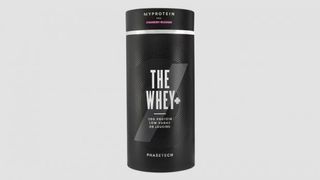
The whey in this powder is a high-quality mix of concentrate, isolate and hydrolysed whey, and each 32g serving contains 26g of protein. Myprotein’s beadlet tech also promises phased absorption of the BCAAs in the powder to best promote muscle growth. The chocolate brownie flavour is a winner, especially if you mix it with milk for an especially rich post-workout treat.
Buy from Myprotein | £35.99 for 960g
SiS Advanced Isolate+
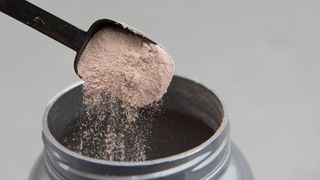
This powder is made purely from whey isolate and packs 31g of protein into a 40g serving. There are 9g of BCAAs, including 5g of leucine, and the carb count is low at 1.7g per serving, 0.6g of which are sugars.
Buy from SiS | £45 for 1kg
Optimum Nutrition Gold Standard Whey
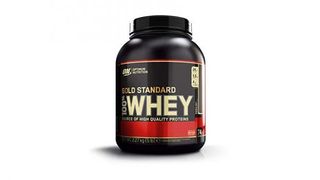
This is a popular option with gym-goers, with an easy-mix blend of hydrolysed whey, whey isolate and whey concentrate providing the 24g of protein in each serving. There’s a wide range of flavours although we reckon it’s hard to look past double rich chocolate, and ON’s Gold Standard Whey is often reduced in annual sales like Black Friday, so keep your eyes peeled and you might be able to stock up for up to 60% less.
Buy on Amazon | £43.98 for 2.27kg
Maximuscle Max Whey
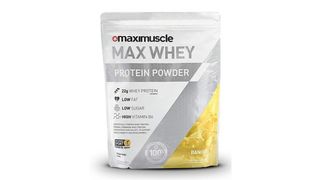
Each 30g serving of this powder contains 23.5g of protein, which is sourced from a mix of whey concentrate and isolate, although heavily skewed towards the former – only 10% is from isolate. So far, so standard, but Maxinutrition has mixed things up a little by packing 7g of BCAAs into the powder as opposed to the usual 5g, with more than 3g of leucine.
Flavour-wise there’s the usual chocolate, vanilla and strawberry, but also a more exciting banoffee option, which is naturally the one we opted to test. We were impressed by the flavour but less so by the texture – the drink remained a little lumpy even after a vigorous shaking.
Buy from Maxinutrition | £20 for 480g
Myprotein Clear Whey Isolate
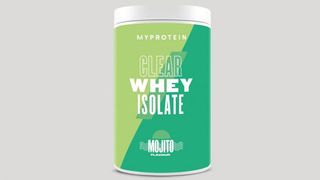
Although whey protein now comes in more flavours than ever before, thick vanilla, chocolate and strawberry shakes still dominate – hardly ideal for refuelling after all-out workouts on hot days. On those days you’ll be better off with the refreshing shake this protein powder makes. The flavours available are joyfully offbeat with mojito, peach tea, and our favourite, rainbow candy, and the quality isn’t compromised with 20g of hydrolysed whey isolate protein in a 25g serving.
Buy from Myprotein | £19.99 for 500g
Supreme Nutrition Diet Whey

Alongside 23.4g of protein, each 30g serving of this powder packs in a host of extra ingredients, including green tea extract and acetyl L-carnitine, all designed to help you burn that little bit more fat. Sucralose is used to provide sweetness, with sugars kept to 1.5g per serving, and there are only 123 calories. It comes in three flavours: chocolate, vanilla, and strawberries and cream. Not the most imaginative trio, but we found the strawberries and cream flavour pleasant enough, though the shake was a little lumpy even after rigorous attempts to mix it.
Buy from Supreme Nutrition | £34 for 1kg

Nick Harris-Fry is a journalist who has been covering health and fitness since 2015. Nick is an avid runner, covering 70-110km a week, which gives him ample opportunity to test a wide range of running shoes and running gear. He is also the chief tester for fitness trackers and running watches, treadmills and exercise bikes, and workout headphones.
